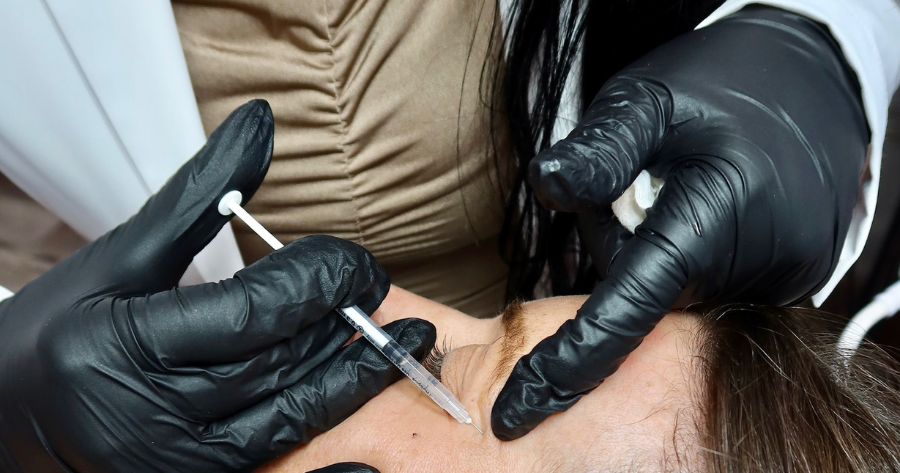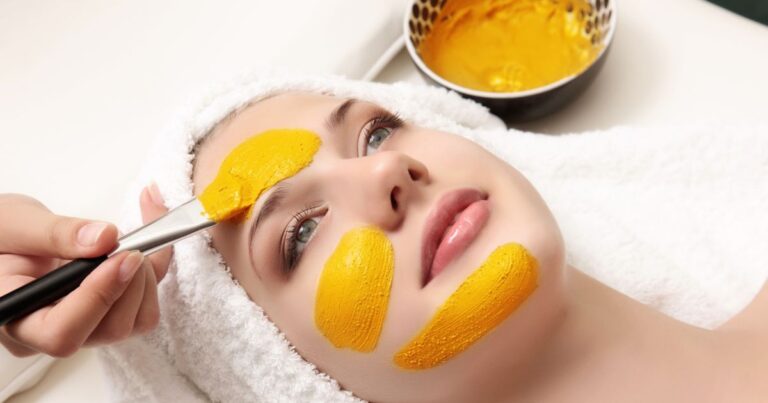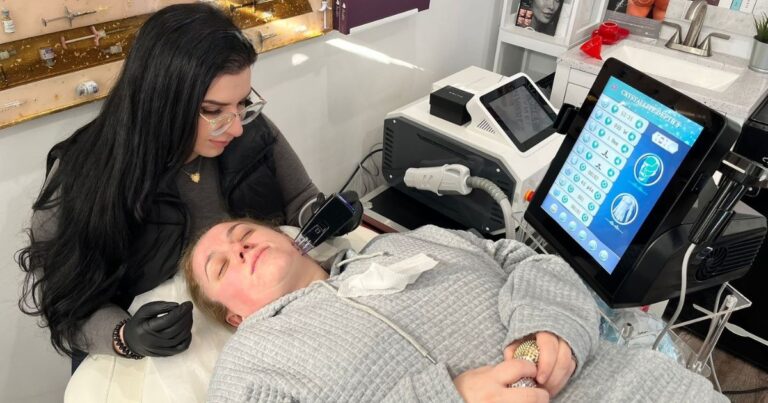Most people think of Botox as a quick fix for fine lines. But it actually does much more than smooth out wrinkles.
Botox has been FDA-approved to treat a range of medical conditions—from chronic migraines to muscle spasms—and ongoing studies continue to expand its use. For many, it’s become a safe, effective option that improves both comfort and quality of life.
If you’ve only considered Botox for cosmetic reasons, this guide will open your eyes to its broader benefits. Let’s break down what Botox is, how it works, and the surprising ways it may help you feel better—inside and out.
What Is Botox and How Does It Work?
Botox is a purified protein made from a natural bacterium called Clostridium botulinum. In small, controlled doses, it blocks nerve signals to muscles. This stops the muscles from contracting, softening wrinkles and improving certain medical symptoms.

The process sounds complex, but the goal is simple—to calm overactive muscles or glands. That’s why it works for fine lines as well as jaw tension or excessive sweating.
It’s injected directly into the target area using a fine needle. Most sessions take under 20 minutes and require no downtime. Results usually appear in a few days and last about three to six months, depending on the condition treated.
Is It Safe?
Botox isn’t just for cosmetic use—it’s FDA-approved for multiple medical conditions, including chronic migraines, eye twitching, overactive bladder, and excessive sweating. That approval is based on years of research, clinical testing, and consistent results.
When administered by a licensed provider, Botox is generally safe. Most side effects are mild and temporary, like minor bruising, redness, or slight swelling at the injection site. Serious complications are rare but possible if Botox is misused or injected incorrectly. That’s why getting treated by a trained medical professional is essential.
Surprising Medical Uses of Botox
Botox may be best known for smoothing out wrinkles, but its ability to calm overactive muscles and block nerve signals has made it a powerful tool in medicine. Below are real, FDA-approved and off-label uses where Botox improves comfort, function, and quality of life, without surgery or daily medication.
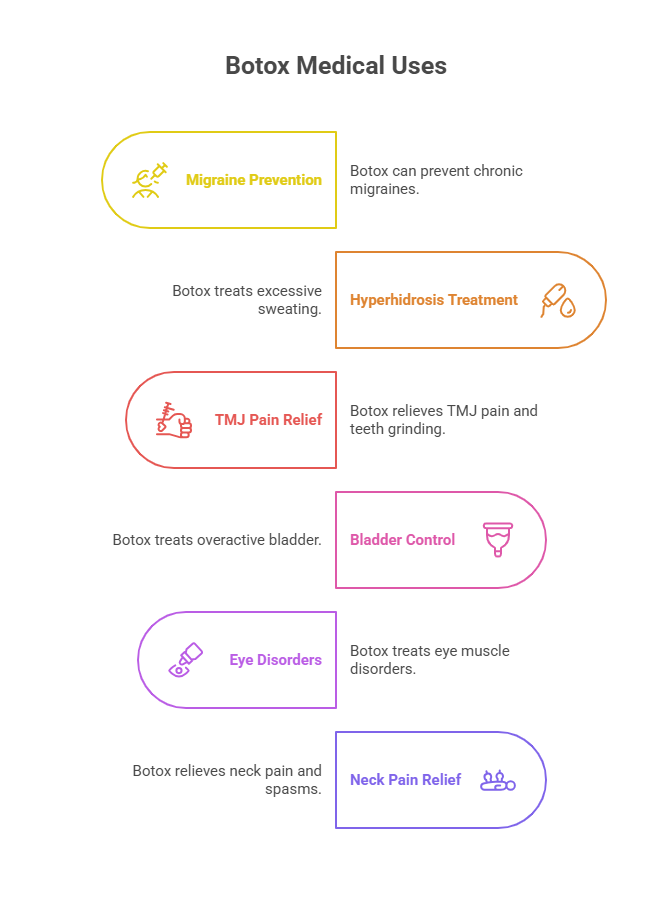
1. Chronic Migraine Prevention
Botox is injected into key areas around the forehead, temples, back of the head, neck, and shoulders. It blocks the release of pain-related chemicals and helps prevent the chain reaction that leads to migraines.
How It Helps
For people with chronic migraines (15+ headache days a month), Botox can reduce the frequency and severity of attacks. Many patients report fewer sick days, better focus, and a major drop in painkiller use after a few sessions. Results build over time, typically improving after the second or third treatment.
2. Excessive Sweating (Hyperhidrosis)
Botox temporarily shuts down the nerve signals that activate sweat glands in specific areas like the underarms, hands, feet, or face.
How It Helps
People with hyperhidrosis often deal with sweat-soaked clothes, skin irritation, and embarrassment. Botox reduces sweating in treated areas for several months, giving people the freedom to dress, shake hands, or socialize without worry. It’s especially helpful when prescription antiperspirants or oral meds don’t work.
3. TMJ Pain, Jaw Clenching, and Teeth Grinding
Botox is injected into overworked jaw muscles, such as the masseter and temporalis. It weakens these muscles just enough to reduce involuntary clenching and grinding.
How It Helps
People with TMJ disorders often struggle with jaw pain, facial tension, headaches, or cracked teeth. Botox can ease this tension without affecting normal chewing or facial movement. It also softens the jawline over time, which some see as an added aesthetic bonus.
4. Overactive Bladder and Urinary Incontinence
Botox is injected directly into the bladder wall, where it relaxes the muscles and reduces sudden urges.
How It Helps
This treatment is life-changing for people who feel like they’re constantly racing to the bathroom or avoiding long outings. Botox reduces urgency, leakage, and frequency, especially for those who haven’t had success with medications or lifestyle changes.
5. Eye Muscle and Eyelid Disorders
Small doses of Botox are injected into the muscles around the eyes to treat conditions like strabismus (misaligned eyes) and blepharospasm (uncontrolled blinking or twitching).
How It Helps
These disorders can make reading, driving, or holding eye contact difficult. Botox helps relax the affected muscles, reducing spasms and restoring control. It was originally approved for these eye issues before it became known for cosmetic use.
6. Neck Pain and Muscle Spasms (Cervical Dystonia)
How It Works
Botox blocks nerve signals in overactive neck and shoulder muscles, which pull the head into awkward, painful positions.
How It Helps
This condition can cause chronic pain and stiffness. Botox helps improve posture, reduce spasms, and make daily movement less painful. Many patients report better sleep and reduced dependence on pain meds.
Emerging and Off-Label Benefits Worth Noting
While Botox has several FDA-approved uses, doctors are discovering more ways it can help with everyday problems—even if those uses aren’t yet officially approved. These emerging benefits are based on real cases, early studies, and consistent results seen in clinical settings.
1. Depression and Mood Support
Botox is sometimes injected into facial muscles responsible for frowning, like the area between the eyebrows. This reduces the brain’s feedback loop that reinforces negative emotions.
How It Helps
Some studies suggest that people feel better emotionally after Botox treatments in these areas. The theory is simple—if you physically stop the frown, the brain may reduce its stress signals. Botox is not a replacement for therapy or medication, but it may support mood in certain cases. Research is still ongoing.
2. Oily Skin and Acne Reduction
When injected into the skin—not the muscle—Botox can reduce oil production by calming the sebaceous (oil) glands.
How It Helps
This treatment is used in small areas, usually the forehead or T-zone. Less oil means fewer clogged pores, which can lead to clearer skin. It’s not a fix for all acne types, but for oily skin that hasn’t responded to products, it can help reduce shine and breakouts.
3. Chronic Itching (Pruritus)
Botox interrupts the nerve signals that trigger the itching response in the skin.
How It Helps
Some people suffer from long-term, unexplained itching that doesn’t respond well to creams or allergy meds. Botox, when injected in the affected areas, can reduce itching for months at a time. This is especially helpful for those with conditions like eczema, shingles, or post-surgical itching.
4. Rosacea and Facial Redness
Botox may reduce inflammation and widen blood vessels, often responsible for redness and flare-ups in people with rosacea.
How It Helps
Some small studies and patient reports show Botox calms flushing and surface-level redness. This use is still experimental, but growing in popularity among dermatologists who treat difficult rosacea cases.
These off-label uses aren’t meant to replace medical treatments but offer additional options for people who haven’t found relief elsewhere. As we learn more, Botox continues to show its value far beyond aesthetics.
Who Should Consider Botox Beyond Cosmetic Use?
Botox can be a practical solution for more than just facial lines. Here’s who might want to consider it—even if they’ve never considered it.
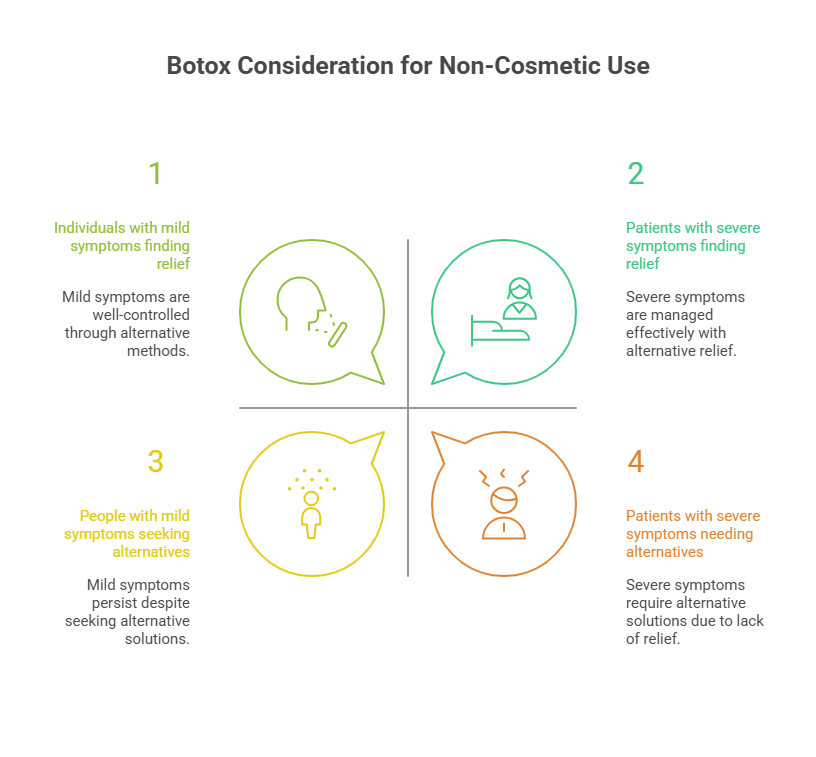
1. People Tired of Taking Daily Medications
If you’re managing pain, an overactive bladder, or muscle tension with daily pills, Botox may offer longer relief with fewer side effects. A few injections every few months could replace a routine of medication that drains your energy or budget.
2. Those Who Want Results Without Surgery
For many conditions, Botox works as a non-surgical option with minimal downtime. Whether it’s bladder issues, eye twitching, or muscle pain, it offers a middle ground between doing nothing and going under the knife.
3. People Whose Symptoms Affect Work or Sleep
When pain, sweating, or tension interfere with focus, sleep, or your ability to perform daily tasks, Botox can help restore balance. It doesn’t just ease the condition—it gives back control over your time and comfort.
4. Patients Already Getting Cosmetic Botox
If you’re visiting your provider for cosmetic Botox, you might be missing out on its medical benefits. Ask if other areas—like your jaw, neck, or underarms—could also be treated at the same time to solve more than one issue.
5. Anyone Who Hasn’t Found Relief Through Other Options
Botox is often used when creams, therapy, or medications fall short. If you’ve tried “everything” and still struggle with symptoms, it might be time to consider Botox as a practical next step.
What to Expect: Treatment, Costs, and Longevity
If you’re considering Botox beyond aesthetics, it helps to know what the process looks like. Here’s a breakdown of how treatment works, how long results last, and what it typically costs.
What a Typical Session Looks Like
A medical Botox appointment usually takes 10–30 minutes. Your provider will ask about your symptoms and mark the injection points. The injections are done with a fine needle and feel like quick pinches. Most people don’t need numbing cream, but it’s available if you’re sensitive.
There’s no recovery time—you can return to work or daily activities immediately. Some people feel minor soreness, redness, or swelling in the treated area, which fades within a day or two.
How Long Does It Last?
Results aren’t instant. You’ll usually notice changes within 3 to 7 days. In some cases, full effects take up to 2 weeks.
Depending on the area and condition treated, results typically last 3 to 6 months. After that, symptoms gradually return. Most patients schedule treatments 2–4 times a year to maintain results.
How Much Does It Cost?
Botox is priced by unit, and the number of units depends on the treated area. Medical treatments often require more units than cosmetic use. On average:
- Medical Botox: $300–$1,200 per session
- Insurance: May cover Botox for migraines, bladder problems, or muscle disorders with proper diagnosis and pre-approval
- Cosmetic-only use: Usually out-of-pocket
Always confirm pricing and coverage with your provider in advance.
Risks, Side Effects, and When to Avoid Botox
Botox is widely considered safe when given by a trained medical provider. But like any treatment, it’s not risk-free. Knowing what to expect—and when to skip it—helps you make an informed choice.
Common Side Effects
Most side effects are mild and go away on their own. These may include:
- Redness, swelling, or bruising at the injection site
- Mild headache or a tight feeling in nearby muscles
- Temporary drooping of eyelids or eyebrows (usually rare and fades within weeks)
These effects are typically short-term and resolve without treatment.
Less Common But Serious Risks
Rare but possible complications include:
- Muscle weakness in unintended areas
- Trouble swallowing or speaking (if injected near the neck)
- Allergic reaction (extremely rare)
These are more likely to happen if Botox is overused or injected incorrectly. That’s why seeing an experienced provider matters.
When You Should Avoid Botox
You should skip Botox or speak with your doctor first if:
- You’re pregnant or breastfeeding
- You have a history of neuromuscular disorders (like ALS or myasthenia gravis)
- You’ve had an allergic reaction to any botulinum product
- You’re taking medications that affect muscle or nerve activity (such as certain antibiotics or muscle relaxants)
Being upfront about your health and medications helps your provider decide if Botox is right for you or if another option is safer.
Conclusion
Botox has come a long way from being just a wrinkle treatment. For many, it’s a medical tool that brings real relief where pills and procedures have fallen short. Whether you’re dealing with pain, muscle tension, or functional issues like bladder control or sweating, Botox offers a practical, low-maintenance solution that fits into real life.
But the key isn’t just knowing what Botox can do—it’s having the right conversation. If something’s interfering with your daily comfort, talk to a licensed medical provider who understands both the cosmetic and therapeutic sides of Botox. You might discover that the same treatment that smooths fine lines can also smooth out deeper disruptions in your everyday life.
It’s not about doing more—it’s about feeling better with less effort.
